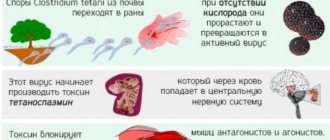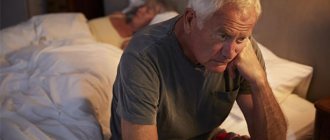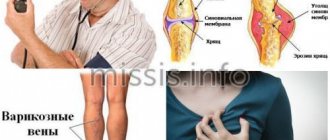Vegetative-vascular dystonia occurs for many reasons, but has one mechanism of development. There are several types of VSD:
- respiratory;
- cardiac;
- hypotonic type;
- according to the hypertensive type;
- mixed.
Doctors at the Yusupov Hospital determine the cause and type of VSD using modern instrumental and laboratory diagnostic methods. After determining the type of VSD, comprehensive treatment is carried out aimed at eliminating the cause of dysfunction of the autonomic nervous system, the mechanism of development of the disease and the leading symptoms. For the respiratory type of VSD, pulmonologists are involved in treatment.
Symptoms that cause shortness of breath
Patients with the respiratory form of VSD experience breathing problems. Patients present the following complaints:
- feeling of lack of air;
- shortness of breath;
- feeling of incomplete inspiration.
Some patients complain of rapid, shallow breathing, they have a desire to take deep breaths of air, and a “sad sigh” appears. There may be a feeling of a “lump” in the throat or squeezing. It is difficult for the patient to be in a stuffy room; there is a need to open the windows. A constant feeling of lack of air during VSD is accompanied by dizziness, a feeling of anxiety, and fear of suffocation. Attacks of suffocation during VSD are possible.
Prevention of apnea BEFORE and AFTER treatment
Apnea is not a harmless breathing disorder, as the increase and intensification of symptoms over time causes serious complications. Therefore, prevention is needed both before and after treatment.
"BEFORE"
Before therapeutic measures, prevention makes it possible to identify the causes of the disease and suppress their further development:
- In the first place is timely examination of somatic diseases and their treatment. We are talking about the thyroid gland, brain, ENT organs, lungs and heart. Systematic monitoring of sugar levels, thyroid hormones, and blood pressure are mandatory parts of the preventive program.
- Control of body weight and its systematic reduction if the excess is more than 10% of the standard is of great importance.
- It is very important to give up habits that are always and everywhere considered harmful. These include alcohol and smoking, stress and a night work schedule.
- You cannot do without regular aerobic exercise - swimming and walking, competitive sports and cycling.
If breathing difficulties are caused by anatomical defects, then you should think about surgical correction of a deviated nasal septum or enlarged tonsils.
"AFTER"
When apnea is over, this does not mean that you can now “release the brakes.” Patients must follow simple rules aimed at consolidating the positive results achieved.
- Eat a low-calorie, vitamin-rich diet
- Limit your intake of carbohydrates and fats, especially hard fats
- Eat food no later than 3, or preferably 4, hours before going to bed
- You may benefit from sleeping on your side or stomach. Place your head and spine at the same level in bed
- Ensure normal humidity in the sleeping area
To prevent the disorder from returning or worsening, practice going for a massage. A good help is soothing baths before bed. This will allow you not only to get a good night's sleep, but also to forget about restless nights forever.
It's hard to breathe and there's not enough air
The feeling of lack of air during VSD occurs under the influence of emotional stress. Emotional reactions of the body, which are formed under stress, prevail, disrupt a person’s stability and resilience, mental adaptation and emotional balance, and “unsettle” the usual rhythm of life. These reactions have two components that act in parallel: psychological (sensual type of displeasure or pleasure), and autonomic. The second mechanism performs the biologically necessary role of energy support for holistic behavior.
Neurologists assign an important role in ensuring the normal functioning of the autonomic component to the hypothalamus and the limbic-reticular complex. The hypothalamus provides unconditioned reflex regulation of the following vital processes:
- breathing;
- blood pressure;
- bladder and digestive tract functions;
- heat generation;
- hematopoiesis;
- sweating;
- pupillary reflex;
- fat and carbohydrate metabolism.
The universal neurophysiological mechanism for triggering VSD is a violation of the hierarchical subordination of the integrative systems of the brain, primarily the limbic-reticular complex. There is a disruption in the relationship between the activating and inhibitory regulatory components, and subsequently the reticular systems are depleted.
The patient experiences insufficient respiratory function after the experience. There is shortness of breath and a feeling of oxygen deficiency. The patient may not be able to take deep breaths at first. It is difficult for a person to inhale, as he experiences pain in the chest. Over time, the patient begins to choke. Shortness of breath with VSD is similar to the clinical picture of an asthmatic attack.
The level of oxygen saturation in the blood decreases and the concentration of carbon dioxide, which stimulates the respiratory center, increases. The patient begins to breathe even more frequently. He is afraid of dying from suffocation. Psychosomatic disorders increase respiratory dysfunction. Due to lack of air, the patient develops a panic attack. Its onset further aggravates the patient's condition. A person tries to breathe deeply to take in more air, but often. This leads to dizziness and numbness in the fingertips due to hyperventilation.
What is the treatment for sleep disordered breathing?
CPAP therapy appeared in 1981
.
This small device was created specifically for the treatment of sleep apnea by Australian professor of medicine Collin Sullivan. CPAP therapy is artificial ventilation of the lungs, which occurs through a small compressor. A tube with a mask is attached to the compressor. Coming out onto the tube and then onto the mask (which is attached to the patient's face), a constant stream of air flows directly into the respiratory tract
. CPAP machine therapy is used by doctors and patients to treat sleep apnea, snoring, respiratory failure, insomnia, depression and other sleep problems.
It is worth noting that CPAP therapy can only be prescribed by a doctor, after diagnosing sleep - polysomnography.
Treatment of apnea and snoring with CPAP therapy can last a year, in some cases a lifetime.
Patients get rid of bad sleep once and for all, they begin to lose weight, their blood pressure returns to normal, the problem of snoring “dissolves”, healthy sleep takes pride of place in a person’s bedroom! Having slept well once, as a rule, patients never part with their CPAP machine! Moreover, modern CPAP machines weigh no more than 2-3 kg and can be used not only at home and away, but also on business trips, on vacation, in the car and even on an airplane!
Stopping intermittent breathing
Doctors at the Yusupov Hospital treat breathing disorders due to VSD with sedatives, physical exercise, and psychotraining. During training sessions, psychologists try to teach the patient how to properly cope with a stressful situation. If the patient is simply very worried, take sedative medications - valerian, novo-passit, motherwort. If the patient has ever suffered a panic attack or has previously been diagnosed with neurosis, neurologists use tranquilizers, antipsychotics, and nootropic drugs. In severe cases, cyclic antidepressants are prescribed.
To relieve an attack of suffocation during VSD, the patient should be seated and calmed down. The patient needs rest. It is necessary to unfasten the compressive elements of clothing and ventilate the room. If this does not help, the patient needs a motherwort or valerian tablet. If there is information about a panic attack or neurosis, you must immediately give the medicine previously prescribed by a psychiatrist.
How to deal with night suffocation
First of all, you need to make a correct diagnosis. After all, there can be many reasons for night awakenings with lack of air: these are bronchial and cardiac asthma, obstructive and central sleep apnea, laryngospasm in gastroesophageal reflux, hyperventilatory attacks in patients with severe vegetative dystonia or hypoventilation in obesity.
So you shouldn’t trust know-it-alls from online forums and online consultants from online stores who promise miracles. It is almost impossible to independently understand and cope with the problem of night suffocation without qualified medical assistance. It is necessary to contact a specialist - a somnologist, and ideally - a somnologist-pulmonologist. This is the kind of doctor who deals with diseases of the respiratory system and disorders of its functioning, including during sleep.
During the examination, the patient will most likely be invited to visit the somnology laboratory for one night for an accurate diagnosis of breathing disorders during sleep
Cardiorespiratory monitoring or, possibly, polysomnography will help determine the presence of apnea and hypoventilation during sleep, as well as clarify their severity. A sleep examination in a sleep laboratory will allow you to establish the correct diagnosis. And depending on the results obtained, the doctor will prescribe adequate treatment. But this condition can and should be treated, since it not only greatly worsens the quality of life, but is also very dangerous due to its consequences and complications.
Choking due to bronchial asthma
The “classic” version of bronchial asthma is manifested by attacks of shortness of breath, quickly developing into suffocation and relieved by taking special medications, primarily from the group of beta2-adrenergic agonists (salbutamol, etc.). An attack can be triggered by the action of any allergen to which the patient is sensitive: cigarette smoke, the smell of perfume, and so on. Sometimes suffocation develops from inhalation of house and book dust, particles of epidermis and animal hair, and even components of fish food, which are of biological origin and therefore can cause allergic reactions.
An asthma attack can occur unexpectedly both during the day and at night. Night attacks often develop under the influence of allergens contained in pillows and blankets. If wool, down or feathers are used as filler, this may well be the cause of the patient’s sleep disturbance due to frequently recurring episodes of suffocation.
For patients suffering from bronchial asthma, it is best to replace bedding and choose synthetic hypoallergenic materials. In addition, it is necessary to consult a doctor so that he can adjust the treatment if the prescribed treatment regimen does not help the person get rid of the symptoms that are bothering him.
Treatment of apnea with folk remedies
Modern treatment for sleep apnea is aimed at eliminating the factors causing the problem. These are not only medications, surgery or CPAP therapy, but also traditional medicine. Using folk remedies in combination with doctors’ recommendations is a good additional way to get rid of apnea.
It is worth using those folk remedies that contain natural substances of plant origin. The following are options that allow you to become, as practice shows, an excellent help in “traditional” treatment:
- Cabbage juice has long been used to treat breathing disorders. You need to add a teaspoon of honey to one glass of liquid, always freshly squeezed. Maybe a little more. The drink should be consumed every evening before bed for at least 1 month.
- Sea buckthorn oil. It will be enough to bury it in your nose, in each nostril, before going to bed for 2-3 weeks. The volume of one serving is 5 drops. This method will help eliminate the inflammatory process in the nasopharynx. The oil also has a healing effect and restores blood circulation in the tissues well.
- Carrots are an equally effective therapeutic remedy against snoring. It should be eaten baked. 1 root vegetable per 1 dose is enough. Take before breakfast, lunch and dinner - that is, 3 times a day.
Among the herbs that will help cope with breathing problems, the most effective are:
- Fenugreek. This herb has a good expectorant effect. It is useful for colds, and its seeds reduce the risk of heart disease and normalize cholesterol levels. True, the seeds have a rather bitter and pungent taste. But it can also be easily removed by soaking it in water. You need to hold them for several hours.
Soaked seeds without bitterness should be chewed well and eaten. A small handful “the width of your palm” will be enough. Therapeutic course – from 2 to 3 weeks. You can also grind the fruits in a coffee grinder and add 200 grams to them. hot water and drink it all before bed. If this option suits you, then do it for 3 to 5 weeks. The results are felt towards the end of the course.
- Eucalyptus, or rather its oil, is also an excellent remedy. It will free the nasopharynx from harmful bacteria. This method is safe and can be used even for children. The oily mass very gently promotes the removal of mucus, which is valuable for colds.
Up to 3-4 drops of oil are added to hot water and immediately begin to inhale the healing steam for five minutes. This is a productive product for inhalation; it is often used to fill an aroma lamp.
- Thyme. Its herb perfectly protects sleep, calms the nerves, which eliminates respiratory disorders, and makes sleep sound and restful.
Thyme oil is also used. It is added to clean water and thoroughly sprayed in the sleeping area daily. If you use a humidifier, add it directly to the device flask. In addition, thyme decoction will also relieve the problem. Place sprigs of the plant directly into the tea. Mint decoction has similar effects.
In addition to fruits, seeds and herbs, the following procedures are deservedly considered excellent options for traditional therapy:
- Moisturizing the mucous surface of the nose and throat with salt water. Do this before bed. You need to pour salt water into your palm and draw it in through one nostril, while closing the other. After this you need to blow your nose. Do the same with the second nostril. The mixture is prepared as follows: you need a teaspoon of rock salt, you can also dissolve sea salt in a glass of water. The temperature should be pleasant, warm. It is important that the salt does not contain dyes or additives. The duration of one procedure is up to 20 minutes.
- Yoga class. The exercises are the simplest, they are performed 25 times in the morning, and can be repeated before bed. If you push your tongue as far forward as possible, lowering it towards your chin, and hold it for 2 seconds, this is useful for eliminating respiratory disorders. To enhance the effect, you need to press on your chin and move your jaw with some force.
And one more thing - namely... singing. Don’t be surprised, this is also a way to get rid of the initial form of respiratory distress, perhaps not a “folk” one, but rather a “physical education” one. 30 minutes every day. Singing, that is, tensing the larynx, will strengthen its muscular corset.
Of course, folk remedies themselves will be, to put it mildly, useless without “medical” treatment. Therefore, remember that “non-traditional therapy” will help eliminate breathing problems, provided that all doctor’s instructions are strictly followed.
What to do?..
Very often, patients report that when they suspected symptoms of apnea, they were at a loss: “What to do if you stop breathing during sleep? What to do? Who to contact?". Fortunately, we have answers to these questions.
First of all, it is important to understand: sleep apnea syndrome cannot be cured on your own at home. That is why the first step towards recovery should definitely be a visit to a doctor who deals with sleep problems - a somnologist. He will be able to diagnose apnea, assess the severity of the condition and select treatment appropriate to the situation.
Causes of shortness of breath
When talking about the causes of shortness of breath, you should not mention physical activity, stuffy rooms, or conditions caused by stress. All these reasons can be easily eliminated by changing the environment around a person, and do not indicate the presence of possible pathologies in the body.
Shortness of breath at rest may indicate cardiovascular and bronchopulmonary pathologies that can threaten a person’s life. That is why you should pay close attention to such symptoms. Chest injuries also need to be evaluated and treated as they are another cause of this symptom.
The main reasons for lack of air are:
- Pneumothorax. A condition in which air accumulates in the pleural cavity of the lungs, causing the lung itself to not function fully.
- Bronchial asthma. With this disease, the airways become very narrow in size, which leads to a lack of air.
- Injuries. If the injury causes damage to the lung, the person may experience shortness of breath.
- Heart failure. A concomitant pathology may be pulmonary edema.
- Lack of air due to a sharp increase in blood pressure.
- Pneumothorax, pulmonary edema, and mechanical injuries are conditions in which a person needs urgent medical attention.
- Also, one of the common causes of lack of air is anemia - iron deficiency anemia. With this disease, the amount of blood in the body is greatly reduced, due to which organ tissues are not supplied with oxygen, since oxygen transfer is the main function of red blood cells and hemoglobin.
All of the above situations require diagnosis and proper treatment. If any of these conditions are left unattended, it can lead to very serious consequences in the future. Therefore, if shortness of breath occurs, you should immediately consult a physician.







